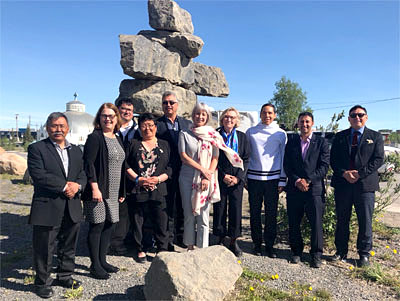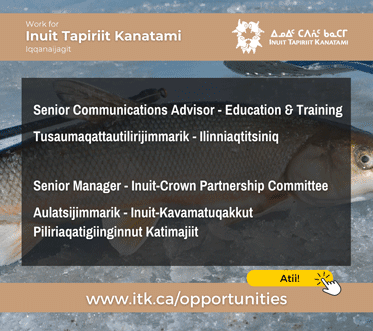The myth of the Inuit Child-First Initiative
How can parents of Inuit children be expected to jump through so many bureaucratic hoops?
Federal ministers stand with Inuit leaders in Inuvik, N.W.T., on June 27, 2018, where they met as part of the Inuit–Crown Partnership Committee and decided to create the Inuit-specific Child-First Initiative. (File photo)
As any parent would, I take my children’s health to heart. This letter is based on my personal experience as a parent applicant to the Inuit Child-First Initiative (CFI), a program delivered by Indigenous Services Canada.
According to the Government of Canada, the Inuit CFI “ensures Inuit children have access to the essential government funded health, social and educational products, services and supports they need, when they need them.”
Instead, CFI demonstrates that the Government of Canada does not understand the Nunavut context. The number of Nunavut applications is low, in great part because the CFI application process is inflexible, intrusive and incompatible with life in Nunavut.
Between May 2019 and February 2020, I submitted seven applications to CFI in order to support my children’s diagnosed health needs. Four of my applications have been successful, one has been rejected, and two are in review.
My seven applications (including revisions) required 25,084 words, over 50 appointments with qualified professionals, and over 40 supporting letters/emails by family physicians, pediatricians, psychologists, social workers, principals, classroom teachers, student support teachers, Government of Nunavut officials, Nunavut community organizations, and the Representative for Children and Youth.
I have used all of my special leave and overtime in lieu hours, as well as some annual leave, in order to meet the incredible demands of the CFI application process (and my children’s health needs based on these applications). I have needed a sick day just to breathe.
For one of the applications to be successful (according to CFI protocols), I was required to submit a total of 11 letters/emails: two letters from a Qikiqtani General Hospital (QGH) locum physician, three letters from our family physician, and one letter from a QGH pediatrician, as well as two letters from classroom teachers, one email from the school board, and two emails from a registered psychologist.
Access to physicians for medical letters is tricky in Iqaluit, even with a regional hospital. Getting an appointment for my children has taken four to six weeks.
How can parents of Inuit children be expected to jump through so many bureaucratic hoops?
As a Qallunaaq parent of Nunavut Inuit children who have been diagnosed by qualified professionals with unique and unmet health needs, I am well aware of my white privilege. As an English-French bilingual individual with 12 years of post-secondary education, I am appalled by the skill set required to complete the CFI application process. Such skills include research, writing, critical thinking, analytical thinking and budgeting, to name a few.
Not only must parents identify gaps in terms of their children’s “unique and unmet needs,” CFI also asked me to define the gaps according to “macro level” gaps and “micro level” gaps. How can parents be expected to do so much analysis?
Moreover, CFI does not provide either forms or templates to support parent applicants (or professionals required to write letters). Therefore, I have created my own application form, Excel spreadsheets, invoice template and letter template—reviewing with each professional the keywords CFI has identified as necessary. Worse, parents must find their own service providers to meet their children’s health needs!
Based on my personal experience, you need access to a computer, a printer, a scanner, internet, long-distance telephone service, a bank account and a personal credit card. It has been extremely convenient to own a car and be able to afford the gas.
Yet, while the federal government process is onerous and ridiculous, the money is there. When I first reached the CFI National Call Centre in May 2019, the representative told me that the sum of $220 million dollars was dedicated to the program for Inuit children under 18, regardless of where they live in Canada.
Does your child require a psycho-educational assessment? Audiological testing? Physiotherapy or occupational therapy? Does your child require either electronics (such as an iPad or Surface Pro laptop) or tutoring services to assist with their classroom learning? Could your child benefit from a specialized summer camp or cultural activities to improve their mental health and self-worth?
I thought so.
I encourage all parents and legal guardians of Inuit children, regardless of where they live in Canada, to apply for the Child First Initiative. Piliriqatigiinniq—let’s work together for a common cause.
But first, I call on the Government of Canada to remove the barriers that prevent the program from working for Inuit children and for their parent applicants.
Laura Thompson
Iqaluit parent
Email your letters to editors@nunatsiaq.com.
Nunatsiaq News welcomes letters to the editor. But we are under no obligation to publish any given letter at any given time.
In our print edition, we usually print letters on a first-come, first-served, space-available basis. In our online edition, we usually print letters as soon as we are able to prepare them for publication.
All letters are edited for length, grammar, punctuation, spelling, taste and libel. You may withhold your name by request, but we must know who you are before we publish your letter.






I’m so glad you acknowledge and admit to the intrinsic and historic guilt embedded in your white privilege. I just found this so stunning and brave!
This was an important segue to the main point of the letter, that the author is capable of navigating the complex CFI system because she is educated and white. You can not hold Inuit to this standard, if you do you are probably a racist.
Thank you, Laura for pointing out these systems of oppression!
“How can parents of Inuit children be expected to jump through so many bureaucratic hoops?”
.
A couple thoughts, the hoops do sound insane and this should be addressed.
.
At the same time, the way this is framed seems very condescending to Inuit though.
Very similar to Inuit access to the Canada Health Non-Insured Health Benefit program through our Department of Health, it seems much more appropriate that this federal program be accessed through the Department of Education.
Based on the technical nature of the process it would be much better if access to this program be facilitated by a Student Support Teacher. It is they that have the actual professional background to do this, not a typical parent. According to their job description:
“Student Support Teachers are employed in each school for the purpose
of providing specialized support for students with intensive/exceptional
needs. These personnel consult and collaborate with teachers,
administrators, parents and other personnel and agencies to support
student success. Through their professional training, Student Support
Teachers can offer specific knowledge and strategies regarding student
diversity and represent a coordinating link among staff.”
i wonder if this is something that the Government of Nunavut Department of Education should be directing their staff to do?
Really give the schools more to do.
Quyanamiik, thank you Laura for speaking out for Inuit across Canada. As an Inuk myself, I find this very complicating to even consider to access it. Because of the requirement , terms of content, even to think of approaching someone in who is responsible for this initiative. It is very complex, time consuming, and even frightening to consider CFI.
I have used CFI to bring my child south for a medical appointment. I was given help though NTI and they explained everything that I needed to provide.
Although this situation is complex, I hope that this does not discourage others from applying for CFI.
To the write, sorry you had to go through all this. It sounds complex and time consuming.
This is great information. Just like so many other programs that are available but have a bureaucratic nightmare to sort through… or are just not talked about.
Like the medical travel assistance for GN workers. if your on your own medical travel or as an escort you can get perdiums. so many people dont seem to know this.
And how hard it is to get funding through the NHC home repair or emergency programs. have to constantly follow up if you hope to get approval. and it seems to take acting like a persistent pushy southerner to get anything done, which doesnt feel good doing it that way.
As an Inuk, I constantly jump through the oppressive, colonizing hoops if I apply for any type of assistance. Most of the time I do not get a response, not even a courtesy email response to say they receive my application. What do I say or do about this. A lot. I ask for help from others who have had successfully been approved and gotten the funds. I compare their application and there does not seem to be any difference. People who have tried to help me get no response either. What else are we to do? I have given up. As an Elder, being treated like this all my life, I have given up on our ‘government ‘. They also jump through hoops. The way of the capitalist system, only money matters. Inuit value family, land, and our culture. Completely opposite.